Looking to make your kitchen more eco-friendly? Wondering how you can reduce water waste and minimize environmental impact at the sink? The answer lies in adopting sustainable practices that conserve resources and promote responsible usage.
Start by using eco-friendly cleaners to minimize chemical pollution in water systems. Promptly fixing leaks can prevent water wastage and reduce utility bills.
Opt for low-flow faucets and install water filter systems to save water and improve water quality. Energy-efficient dishwashers can further minimize water and energy consumption during dishwashing.
Recycle water when feasible, such as using leftover water for plants. When choosing sink materials, opt for sustainable options like bamboo or recycled glass.
Lastly, avoid disposable plastics by opting for reusable alternatives. These steps collectively transform your sink into an eco-conscious space, promoting sustainability one wash at a time.
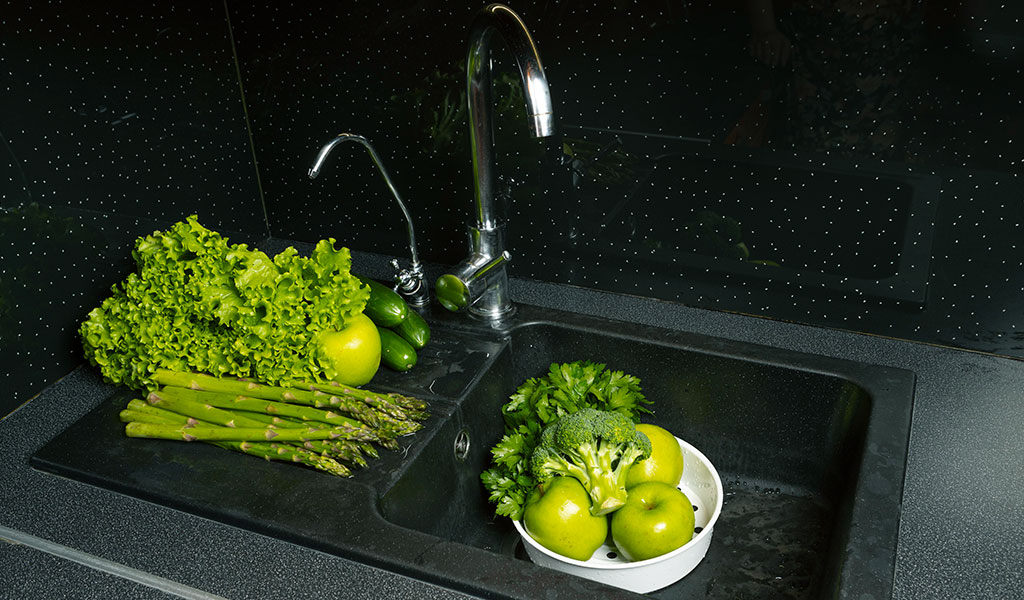
How Small Changes at the Sink Can Contribute to a Greener Lifestyle?
Absolutely, making small changes at the sink can have a big impact on living a greener lifestyle. Let’s explore some simple yet effective steps we can take together:
- Choose Eco-Friendly Cleaners: When we opt for natural or eco-friendly cleaning products, we reduce the amount of harmful chemicals entering our water systems.
- Fix Leaks Promptly: Did you know that a small leak can waste a surprising amount of water? By fixing leaks promptly, we not only save water but also lower our utility bills.
- Use Low-Flow Faucets: Upgrading to low-flow faucets can significantly reduce water usage without compromising functionality. It’s an easy swap that makes a big difference.
- Install a Water Filter: Filtering our water at the sink can help improve water quality and reduce the need for bottled water, which cuts down on plastic waste.
- Opt for Energy-Efficient Appliances: When it’s time to upgrade our dishwasher or other appliances, choosing energy-efficient models can save both water and electricity.
- Recycle Water: Instead of letting water go to waste, we can recycle it for other uses like watering plants or cleaning.
- Choose Sustainable Materials: When remodeling or replacing sinks, consider materials like bamboo or recycled glass, which are more environmentally friendly.
- Say No to Disposable Plastics: Switching to reusable dishcloths, sponges, and utensils reduces our reliance on single-use plastics, helping to reduce plastic pollution.
By incorporating these small changes into our daily routine at the sink, we can actively contribute to a greener lifestyle. It’s about making mindful choices that benefit both our homes and our planet. Together, we can make a positive difference!
Top 8 Tips to Green Your Sink
When it comes to the eco-friendly lifestyle, what you are doing in the kitchen really matters. Here, you can try some green tricks while using your sink. Even though the efforts are not so big, still, they are pretty effective.
1. Use Eco-Friendly Cleaners
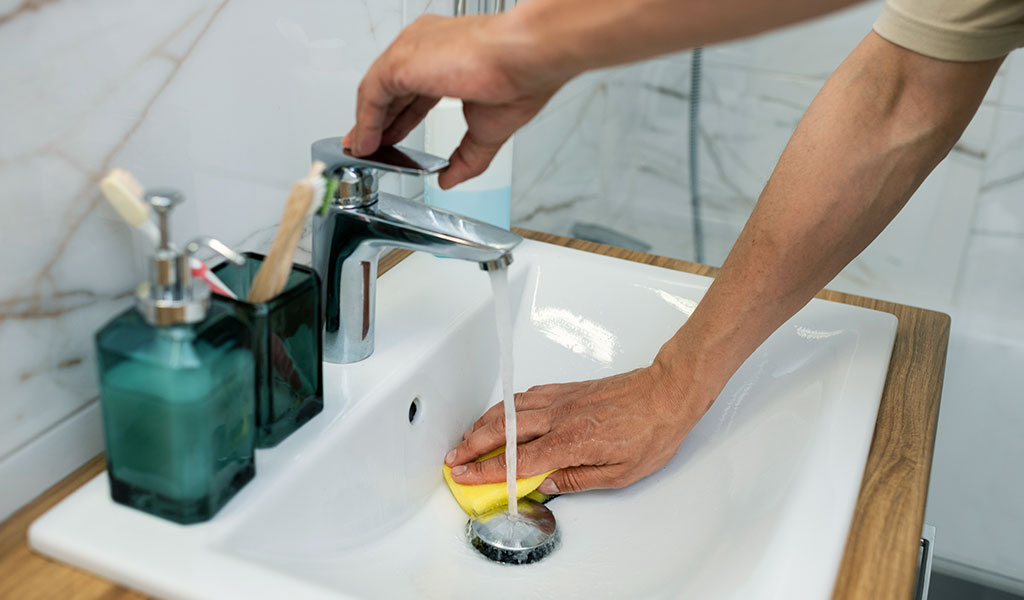
Switching to eco-friendly cleaners is an excellent way to green your sink and reduce your environmental impact.
Traditional cleaning products often contain harsh chemicals like ammonia, chlorine, and phosphates, which can pollute water systems and harm aquatic life when washed down the drain.
Eco-friendly cleaners, on the other hand, use natural and biodegradable ingredients such as plant-based surfactants and essential oils. These ingredients are safer for the environment and do not leave behind harmful residues.
When choosing eco-friendly cleaners, look for products labeled as non-toxic, phosphate-free, and biodegradable. These cleaners effectively clean your sink and dishes without compromising on performance.
They remove grease, grime, and stains while leaving a fresh and natural scent. By using eco-friendly cleaners, you not only contribute to cleaner water systems but also create a healthier indoor environment for your family.
2. Fix Leaks Promptly
Addressing leaks promptly is crucial for conserving water and maintaining a sustainable home. Even a small drip from a faucet or a leaky pipe can waste a significant amount of water over time.
Not only does this waste water resources, but it also increases your water bill unnecessarily. Regularly inspect your sink, faucets, and pipes for any signs of leaks, such as dripping or puddling water.
Replace worn-out washers, seals, or faulty parts to fix leaks. If you’re unsure how to repair leaks yourself, consider hiring a plumber to do the job efficiently.
By fixing leaks promptly, you’ll prevent water wastage and contribute to water conservation efforts in your community. It’s a simple yet impactful way to make your home more sustainable and eco-friendly.
3. Look for Low-Flow Faucets
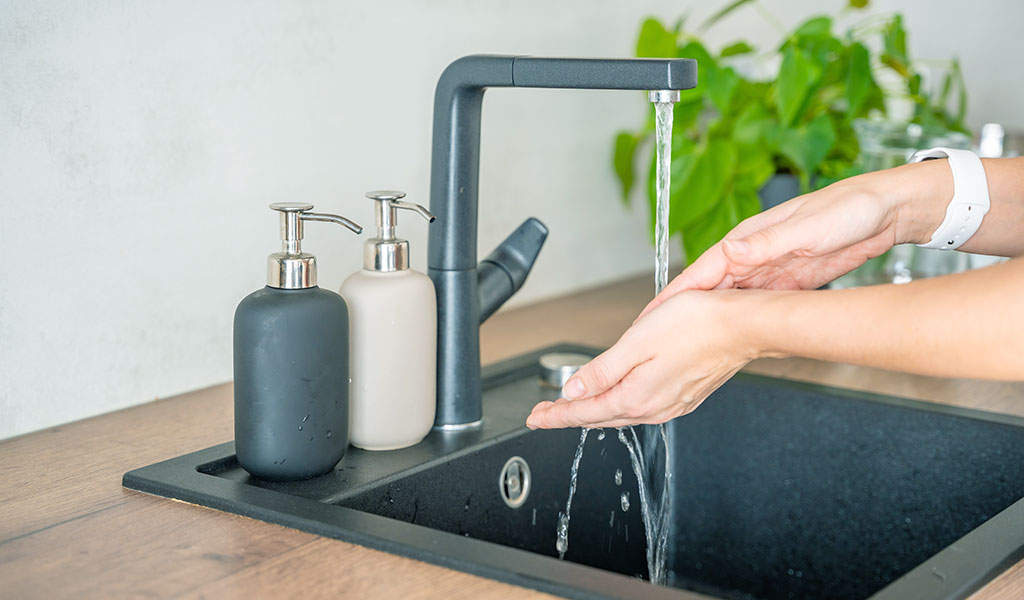
Choosing low-flow faucets is a practical solution to reduce water usage at the sink without sacrificing convenience. Low-flow faucets are designed to restrict the flow rate of water while maintaining adequate pressure for everyday tasks like washing dishes and hands.
These faucets typically use aerators or flow restrictors to control water output, reducing water consumption by up to 30% or more compared to standard faucets.
Look for Water Sense-certified faucets, that meet EPA criteria for water efficiency and performance. Installing low-flow faucets not only helps conserve water but also saves you money on your water bill over time.
When shopping for low-flow faucets, consider the design, finish, and features that best suit your kitchen or bathroom décor. By opting for low-flow faucets, you’ll make a positive impact on water conservation and contribute to a greener lifestyle.
4. Install Water Filter Systems
Installing a water filter system is a smart choice to improve water quality and reduce the need for bottled water. Water filter systems remove impurities and contaminants from tap water, providing you with clean and safe drinking water right from your sink.
There are various types of water filter systems available, including under-sink filters, faucet-mounted filters, and whole-house filtration systems. Choose a system based on your water quality needs and preferences.
Look for filters certified to remove common contaminants like chlorine, lead, pesticides, and sediment.
By installing a water filter system, you’ll not only enjoy better-tasting water but also reduce plastic waste from single-use water bottles. It’s a sustainable solution that promotes environmental conservation and supports your health and well-being.
5. Choose Energy-Efficient Dishwashers

Opting for energy-efficient dishwashers can significantly reduce water and energy consumption in your kitchen. Energy-efficient dishwashers use advanced technology and features to clean dishes effectively while minimizing resource usage.
Look for dishwashers with an ENERGY STAR certification, which indicates superior energy efficiency. These models are designed to use less water and electricity without compromising on cleaning performance.
Features like soil sensors, eco-friendly wash cycles, and efficient water distribution systems contribute to overall water and energy savings.
When using an energy-efficient dishwasher, wait until it’s fully loaded before running a cycle to maximize efficiency. Scraping food residues instead of pre-rinsing dishes can also save water.
By choosing an energy-efficient dishwasher, you’ll save money on utility bills and reduce your environmental impact.
6. Recycle Water When Possible
Recycling water is a sustainable practice that can be implemented both indoors and outdoors. Instead of letting water go to waste, consider ways to reuse it for other purposes.
For instance, collect water used for rinsing fruits and vegetables and use it to water indoor or outdoor plants. You can also reuse water from cooking pasta or boiling vegetables to nourish your garden.
Use a bucket to catch shower water while it warms up and use it for flushing toilets or watering plants.
Recycling water not only conserves this precious resource but also reduces your overall water consumption. It’s a simple yet effective way to adopt eco-friendly practices and contribute to a greener lifestyle.
By incorporating water recycling into your daily routine, you’ll make a positive impact on water conservation efforts in your home.
7. Select Sustainable Materials for Sinks
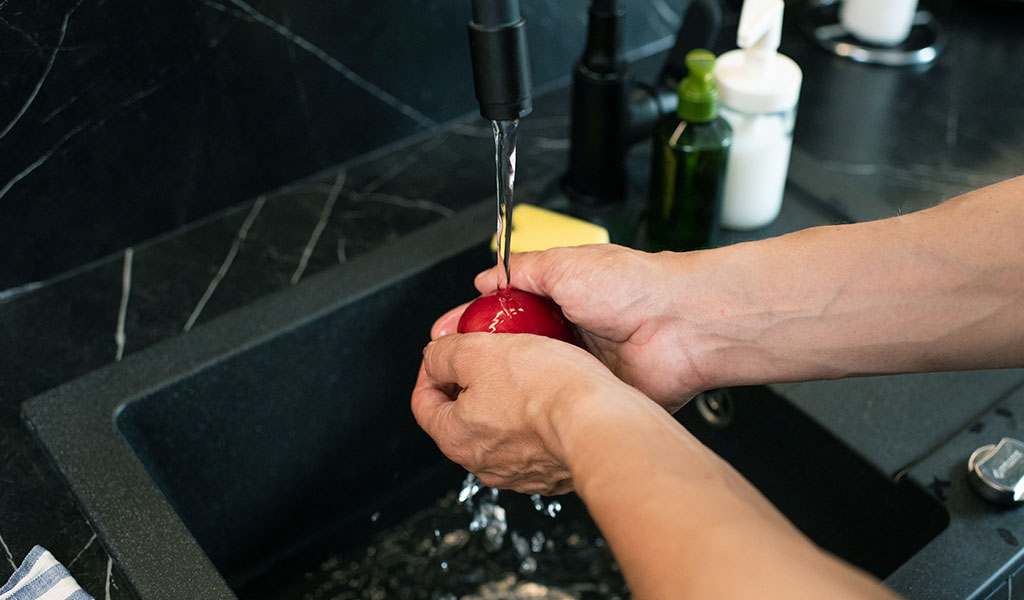
Choosing sinks made from sustainable materials is a key step in greening your kitchen or bathroom. Traditional sink materials like stainless steel or porcelain may not be the most environmentally friendly options due to their production processes and resource requirements.
Opt for sinks made from sustainable materials such as bamboo, recycled glass, or natural stone. These materials are renewable, eco-friendly, and often have a lower environmental impact compared to conventional sink materials.
Bamboo, for example, is a fast-growing renewable resource that makes durable and stylish sink options. Recycled glass sinks give a second life to materials that would otherwise end up in landfills.
When selecting a sustainable sink, consider factors like durability, aesthetics, and compatibility with your existing décor. Look for certifications or labels that verify the sustainability of the materials used.
By choosing sinks made from sustainable materials, you’ll contribute to reducing the demand for virgin resources and support eco-friendly manufacturing practices.
8. Avoid Disposable Plastics
Reducing or eliminating the use of disposable plastics is essential for a greener sink and overall sustainable lifestyle. Disposable plastics like plastic utensils, straws, and dishsponges contribute to plastic pollution and harm wildlife when they end up in oceans and landfills.
Instead of using disposable plastics, opt for reusable alternatives. Invest in durable stainless steel or bamboo utensils and straws that can be washed and reused.
Use cloth dish towels and reusable sponges made from natural materials like cellulose or loofah to clean dishes instead of disposable plastic scrubbers.
When shopping, look for products with minimal packaging or choose items packaged in recyclable materials. By reducing your reliance on disposable plastics, you’ll significantly reduce your household waste and contribute to a cleaner environment.
Making these conscious choices at your sink helps create a sustainable and eco-friendly home environment, one step at a time.
Other Ways to Save Water
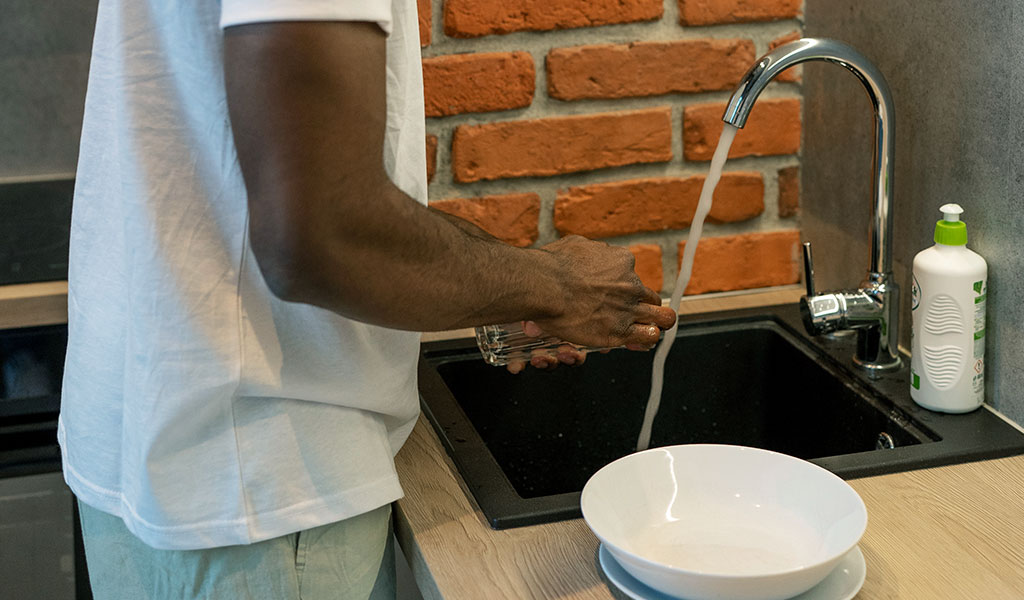
When it comes to conserving water beyond the kitchen, there are plenty of impactful ways we can contribute to water conservation efforts. Let’s explore some additional strategies that can help us save water around the house:
Optimize Outdoor Watering
Adjust sprinklers to water plants and lawns efficiently, minimizing runoff and evaporation. Water early in the morning or later in the evening to reduce water loss due to evaporation during hot hours.
Fix Leaky Faucets and Toilets
Leaky faucets and toilets can waste significant amounts of water over time. Be sure to fix any leaks promptly to prevent water wastage.
Install Water-Efficient Fixtures
Upgrade showerheads and faucets with water-efficient models that use less water without compromising performance. Consider installing low-flow toilets that use less water per flush.
Capture Rainwater
Install a rain barrel to collect rainwater from your roof. This harvested water can be used for watering plants and gardens, reducing reliance on potable water.
Use Mulch in Gardens
Apply a layer of mulch around plants and garden beds to retain moisture in the soil, reducing the need for frequent watering.
Take Shorter Showers
Encourage family members to take shorter showers to conserve water. Consider installing a shower timer or using a water-saving showerhead to reduce water usage.
Reuse Water Indoors
Collect and reuse water from activities like washing vegetables, boiling pasta, or rinsing dishes to water indoor plants or flush toilets.
By adopting these practices, we can significantly reduce our household water consumption and contribute to water conservation efforts in our community.
Every drop saved makes a difference, and together, we can make a positive impact on our environment by conserving this precious resource. If you have any questions or need more tips on water conservation, feel free to ask!
Wrapping Up
Implementing these top 8 tips to green your sink is a meaningful step towards promoting sustainability in your home.
By making these simple yet effective changes, you not only reduce your environmental footprint but also contribute to conserving valuable resources. Let’s recap the key takeaways:
Firstly, using eco-friendly cleaners minimizes chemical pollution in water systems while fixing leaks promptly prevents unnecessary water wastage. Opting for low-flow faucets and installing water filter systems not only saves water but also improves its quality.
Choosing energy-efficient dishwashers reduces both water and energy consumption during dishwashing. Recycle water whenever possible, such as using leftover water for plants or other household tasks.
When selecting sink materials, prioritize sustainable options like bamboo or recycled glass to support eco-friendly practices.
These collective efforts transform your sink into an environmentally conscious space, contributing to a greener lifestyle overall. Remember, every small change counts, and together, we can make a positive impact on our planet.
